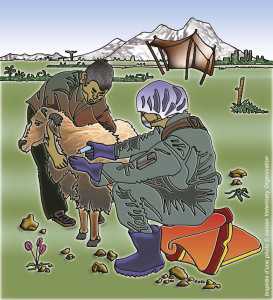Past factors behind the spread
Scientists know today that in the past, PPR was present in numerous countries where rinderpest raged, but it was overlooked or misdiagnosed in the absence of reliable tests that could distinguish between the two diseases. After the last rinderpest outbreak was stamped out in the early 2000s, international animal health organizations turned their attention to PPR, which had been hitherto neglected. When the circulation of the rinderpest virus was arrested and the vaccination campaigns against this disease ceased, small ruminants were left completely exposed to PPR. It had been fairly common for veterinary services to vaccinate small ruminants with the rinderpest vaccine, which conferred excellent cross-immunity against PPR. During the control phase of the rinderpest eradication program, the use of this vaccine, even for small ruminants, was banned, yet a homologous PPR vaccine was not yet in circulation to fill the gap. Furthermore, some argue that the end of rinderpest vaccinations in cattle increased their receptivity to the PPR virus and that cattle could play a role in PPR transmission, something which has never been demonstrated. |






